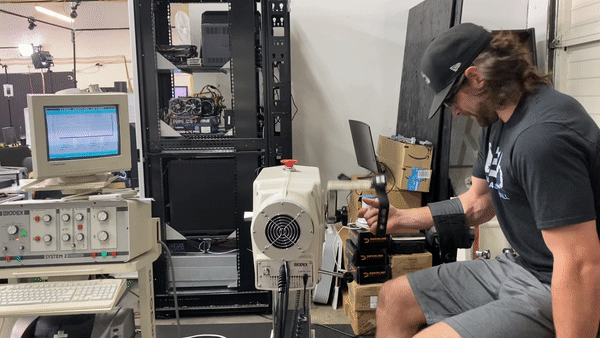Why Driveline got a Biodex

If this is the first time seeing this video, it probably leaves you with a handful of unanswered questions:
- What is this machine?
- How did you discover it?
- What are you going to do with it?
In this blog, we will answer those questions one at a time.
What is this machine?
The machine above is a Biodex System 2 Isokinetic Dynamometer.
- Isokinetics
-
- An accommodating variable-resistance exercise performed at a constant speed, with the resistance matching the muscle force at that speed of movement.
- As muscle force changes, the resistance changes because the speed remains constant.
- The individual’s muscular resistance meets a proportional amount of resistance throughout a range of motion.
More specifically, the Biodex allows us to isolate/assess individual joints. By isolating various joints, we can identify where a player is weakest and what movements specifically might be contributing to those weaknesses. Within each test, we can track the following (plus much more):
- Peak Torque (ft-lbs)
- Time to Peak Torque (msec)
- Angle of Peak Torque (deg)
- Peak Torque/Body Weight (%)
How did we discover the Biodex?
To gather more information regarding various metrics and their role in elbow pain, we constructed an apparatus to measure the isometric strength of multiple movements. We measured isometric wrist flexion/extension and isometric shoulder er/ir, in addition to standard grip strength.
We constructed our apparatus using a Camry Digital Hand Dynamometer Grip Strength Measurement Meter and mule tape. This device worked pretty well for the first few weeks. As we collected more tests, however, we began to question the reliability of our device—we were getting significantly different measurements between reps, and it was difficult to distinguish the correct from incorrect.
We knew that we wanted/needed to continue to explore the role of wrist, forearm, and shoulder strength in baseball-specific activity, but needed a new method.
In the process of searching for other methods with which to develop a strength profile for the wrist and forearm, we came across an article titled Isokinetic profile of wrist and forearm strength in elite female junior tennis players (Ellenbecker et. al, 2006). This article discussed the differences in wrist and forearm strength between dominant and non-dominant arms in tennis players. Their study found that wrist flexion/extension and forearm pronation strength were significantly greater on the dominant arm.
The ability to objectively measure the strength of these muscle groups in an isolated manner was of considerable interest to us, as they are the primary muscles shown to reduce loading on the UCL.
Luckily, we were able to meet up with the lead author of the study, Dr. Todd Ellenbecker, in Scottsdale, AZ, to chat and get firsthand experience with the machine. While Dr. Ellenbecker primarily focuses on research involving tennis players, we were able to pick his brain and discuss how this type of testing could apply to baseball pitchers.
After seeing the machine firsthand, we were further sold on this idea and underwent a month-long quest for a Biodex system of our own. While we explored multiple options—even venturing as far as Miami—we ultimately were able to find a Biodex system not too far away in Kennewick, WA, which now resides at the Driveline facility.
What are we going to do with the Biodex?
By acquiring a Biodex Isokinetic Dynamometer, our primary goal is to further evaluate the role that forearm, wrist, and shoulder strength may play in the health of baseball pitchers. In addition, we can objectively assess various joints/movements and make comparisons to motion capture data gathered at our in-house biomechanics lab.
Since acquiring this machine, each athlete who has thrown in the biomechanics lab at Driveline has also undergone a Biodex assessment. This assessment consisted of:
- Forearm Pronation & Supination
- Wrist Flexion & Extension
- Lead Leg Knee Flexion & Extension
- Shoulder External & Internal Rotation
What we can do with the data?
While the four tests above serve as the first iteration of our Biodex protocol, they are certainly not the limit for what we can/will be able to do with this machine. With the above data alone we can:
- Investigate the role of forearm and wrist strength on the Biodex to joint kinetics (forces on the elbow and shoulder) within the pitching motion
- Compare the angle of peak torque from lead leg knee extension on the Biodex to the degree of front knee flexion at foot plant found in the biomechanics lab
- Evaluate Shoulder ER/IR Strength Ratio more accurately
- Investigate the role of forearm pronation/supination strength as measured by the the Biodex to a pitcher’s arsenal
- Higher supination strength = Better breaking ball?
- Higher pronation strength = Better changeup?
In the future
In the future, we expect to have the ability to:
- Validate previous research into the role of shoulder abduction on shoulder er/ir strength
- Investigate the role of hip er/ir, hip abduction/adduction, and ankle inversion/eversion strength on lower half movement strategies in the pitching motion
- Study the effect of interventions involving isokinetic training during the pitch design process on a pitcher’s ability to change their arsenal
This is just the tip of the iceberg in terms of what we can evaluate and learn now that we have the Biodex at Driveline.
Such additions will allow Driveline to continue to push the state of research in baseball forward as a whole and will open new avenues for assessment/training protocols.
By Devin Rose and Dean Jackson
Comment section
Add a Comment
You must be logged in to post a comment.
Peter Nash -
Groundbreaking